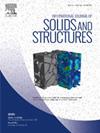Geometric effects on the crashworthiness of composite Kresling origami tubes
IF 3.4
3区 工程技术
Q1 MECHANICS
International Journal of Solids and Structures
Pub Date : 2024-12-18
DOI:10.1016/j.ijsolstr.2024.113199
引用次数: 0
Abstract
Composite Kresling origami tubes consisting of multiple cells exhibit stable cascading collapse behavior under compression and this collapse behavior can be tailored by manipulating various geometric parameters. Previous research has demonstrated that this collapse mechanism can result in more progressive crushing behavior compared with composite straight-walled tubes. However, the energy absorption behavior of the Kresling origami tubes has not been sufficiently studied. In this study, we investigate the effects of the Kresling unit cell height and twist angle on crashworthiness performance with an experimentally validated numerical model. We also vary the number of unit cells in a tube to trigger unique collapse modes. We found that the twist angle of Kresling origami unit cells and the number of unit cells in a tube all significantly affected the energy absorption of the tubes. We confirmed that composite Kresling origami tubes can potentially outperform conventional straight-walled cylinders if the proper tuning of these parameters is achieved.
求助全文
约1分钟内获得全文
求助全文
来源期刊
CiteScore
6.70
自引率
8.30%
发文量
405
审稿时长
70 days
期刊介绍:
The International Journal of Solids and Structures has as its objective the publication and dissemination of original research in Mechanics of Solids and Structures as a field of Applied Science and Engineering. It fosters thus the exchange of ideas among workers in different parts of the world and also among workers who emphasize different aspects of the foundations and applications of the field.
Standing as it does at the cross-roads of Materials Science, Life Sciences, Mathematics, Physics and Engineering Design, the Mechanics of Solids and Structures is experiencing considerable growth as a result of recent technological advances. The Journal, by providing an international medium of communication, is encouraging this growth and is encompassing all aspects of the field from the more classical problems of structural analysis to mechanics of solids continually interacting with other media and including fracture, flow, wave propagation, heat transfer, thermal effects in solids, optimum design methods, model analysis, structural topology and numerical techniques. Interest extends to both inorganic and organic solids and structures.

 求助内容:
求助内容: 应助结果提醒方式:
应助结果提醒方式:


